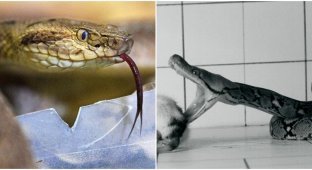Let's get acquainted with ten non-venomous snakes of the central European part; most species currently live in the south (Caucasus, Black Sea region), but no one has yet canceled warming (let's remember the Mediterranean grape snail, which today can be found north of the Moscow region). As usual, for those who are too lazy to read the video at the end. 
1. Already ordinary 
In first place, the common grass snake (lat. Natrix natrix) is the most common species of non-venomous snake in the temperate latitudes of Europe. Large snakes with a body length of up to 120 cm (although there were also specimens up to 2 meters long). The upperparts are grey, olive, black or brown, often with dark spots, sometimes staggered, and narrow transverse stripes. Externally, common snakes are usually easily distinguished from other snakes by their “yellow ears” - pronounced markings on the head, often yellow, but sometimes white and orange. Not aggressive at all. At the sight of a man, he flees for his life.
2. Already watery 
The water snake (lat. Natrix tessellata) is a species of snake from the genus true snakes. A large snake with a body length of up to 140 cm. The upper side of the body is olive or brownish in color, usually with dark, more or less checkerboard spots or narrow transverse stripes on the back. On the back of the head there is a V-shaped black spot, with its apex facing forward. It is strongly associated with bodies of water (both salty and fresh), where it spends much more time than the common grass snake. It swims well, easily resists the current, and can stay under water for a long time. The majority of the diet consists of fish. On the Azov and Crimean estuaries he often hunts bulls, for which he received the nickname “bull-catcher”. The merman is no longer aggressive; when he sees a person, he usually tries to hide in the water or in a shelter.
3. Medyanka 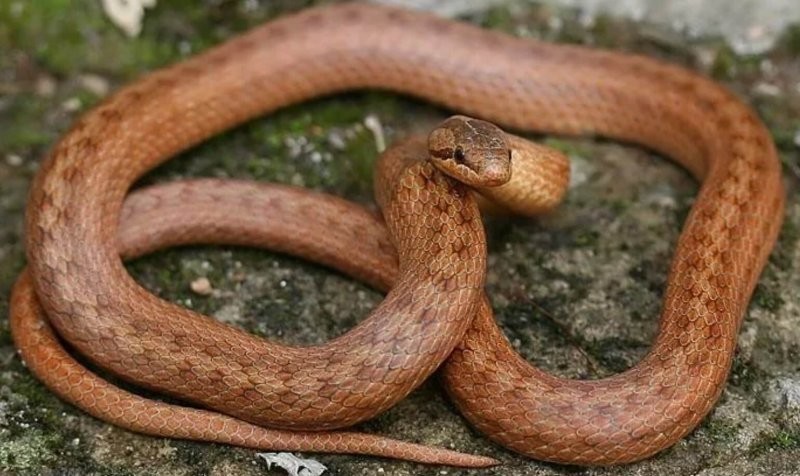
The common copperhead (lat. Coronella austriaca) is a species of snake of the genus copperhead. The body length rarely exceeds 60-70 cm. The copperhead is clearly distinguished from other European snakes by the presence of a dark stripe passing through the eye together with a round pupil. The color of the copperhead's back varies from gray to yellow-brown and copper-red. The iris of the eyes of the common copperhead is yellow or red. Copperheads prefer sunny edges, dry meadows and clearings in various types of forest, avoiding damp places, although they swim well. Copperheads feed predominantly (almost 60%) on lizards, less often (up to 5% of occurrence) on other small vertebrates (mice, voles, shrews and chicks of passerines, spadefoots, young individuals of other species of snakes). The rest of the prey comes from insects. The copperhead's prey is compressed in body rings (like boa constrictors), eating it alive. Cases of cannibalism have also been recorded among them. The copperhead defends itself from its enemies by squeezing into a tight ball, into which it hides its head and, hissing, lunges towards danger.
4. Caspian snake 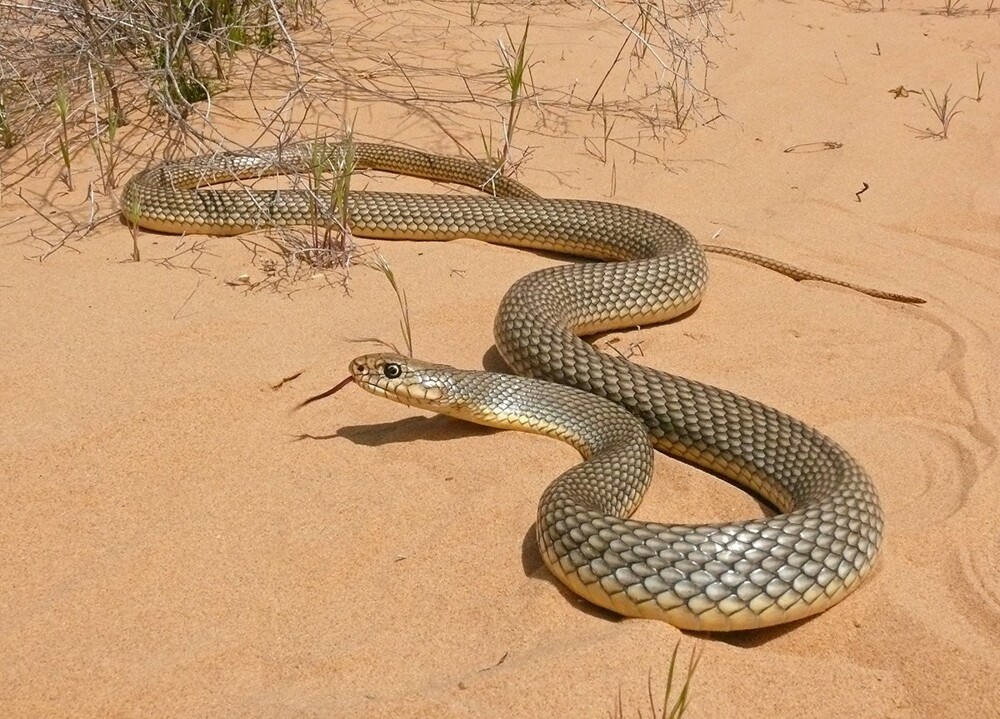
The Caspian or yellow-bellied snake (lat. Dolichophis caspius) is a large snake from the colubrid family. One of the largest snakes in Europe: the length of an adult can reach 200 cm, in rare cases 250 cm. The color of the upper body of an adult snake can be olive-brown, yellowish-brown, reddish or cherry-red. There are very dark, almost black specimens. The eyes protrude slightly outward, with a round pupil. Yellow spots are often developed around the eyes. Inhabits open and semi-open arid biotopes - steppes, semi-deserts, rocky areas, bushes, forest belts, slopes of ravines and ravines, river cliffs. The Caspian snake is known for its aggressive nature. Unlike other snakes, it does not try to hide from an approaching person, but rather curls up in rings like a poisonous snake and throws 1.5-2 m, trying to get in the face. The bite is painful, but in itself does not pose a health hazard.
5. Patterned runner 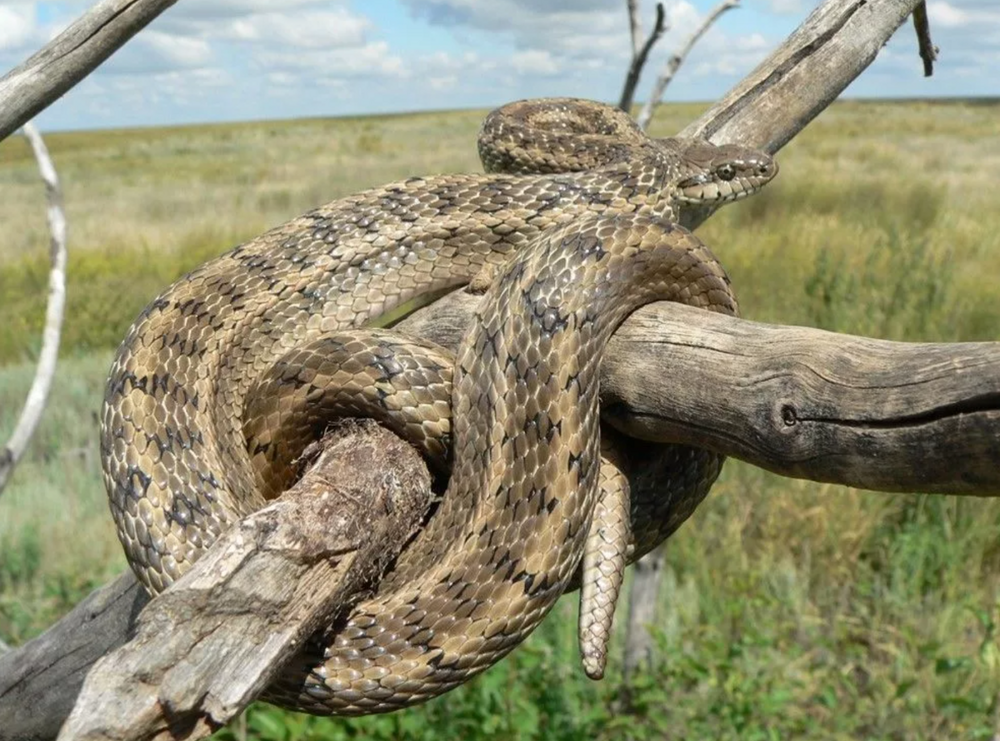
The ornate snake (lat. Elaphe dione) is a species of non-venomous snake from the family Colubridae. Reaches a length of 1.5 m. The species is characterized by very variable coloration. The general background of the body above is grayish-brownish, sometimes with a brown tintcom, with four brown longitudinal stripes (two of which extend onto the tail) and with blackish spots. On the upper surface of the head there is a specific pattern that changes with age. The patterned snake is well adapted to living in a wide variety of conditions in several natural zones: from steppes and deserts to coniferous and mixed forests. It climbs excellently and moves quickly both along tree branches and on the ground, swims and dives well. The diet includes small mammals (the main food source in many parts of the range), birds, snakes, amphibians, fish and insects. Depending on the biotopic preferences of the snake, the composition of the feed may change towards the predominance of one of their types. Eats chicks from bird nests.
6. Collared Eirenis 
Collared Eirenis (lat. Eirenis collaris) is a species of non-venomous snake from the family Colubridae. A medium-sized snake, the body length without a tail reaches 50 cm. The color is uniform grayish-olive, brownish-gray, brownish-gray, red-brown or pinkish-beige. Behind the head on the neck there is a brown, black-brown or black transverse stripe in the form of a collar, from which the species got its name. Inhabits semi-deserts, clayey and rocky, in their open rocky areas with sparse xerophytic vegetation. These snakes feed mainly on invertebrates: crickets, beetle larvae, spiders, woodlice, locusts, earthworms, and can occasionally eat small lizards.
7. Common blind snake 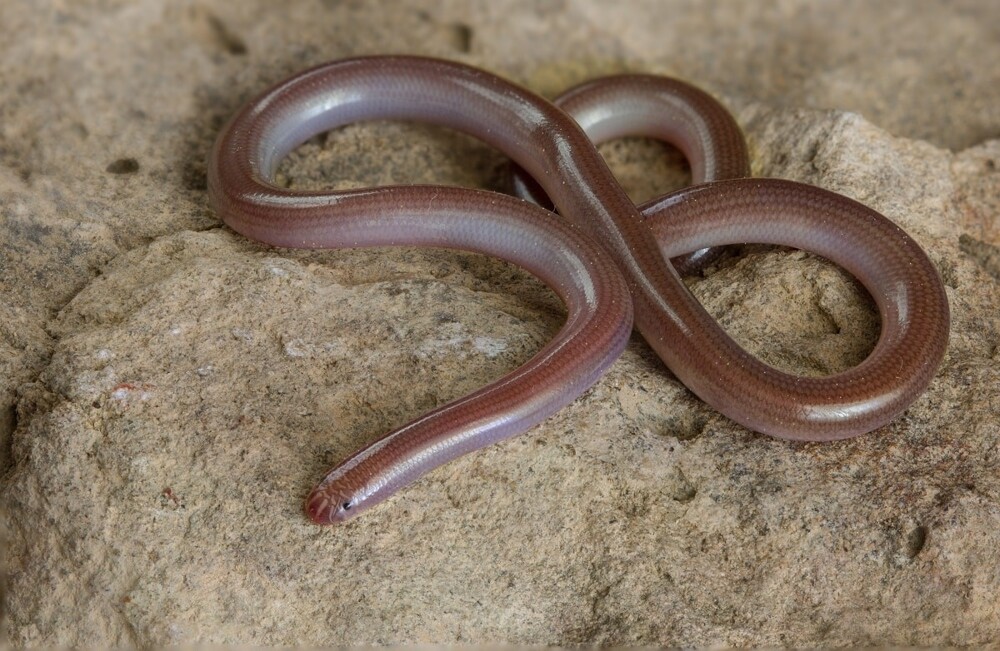
The common blind snake, or worm-shaped blind snake (lat. Xerotyphlops vermicularis) is a species of snake of the family Blind snake. A small snake, up to 38 cm long including tail, resembling an earthworm in appearance. The color of the upper body is brownish or reddish-pink, darker on the tail. The bottom is lighter. Inhabits dry, gentle and moderately steep rocky slopes with sparse xerophytic vegetation, often found on melon fields. It usually lives under stones or under melons and watermelons, where it penetrates from below through long narrow burrows, reminiscent of earthworm passages. Often lives in the nests of ants and termites. Inside the passages, it moves equally easily with both the front and rear ends forward. When turning away the stone, the snake, quickly wriggling its whole body, tries to go underground, using burrows, as well as cracks and holes in the soil. It feeds on ants and their larvae, centipedes and small insects. It is completely harmless to humans.
8. Sand boa 
The sand boa (lat. Eryx miliaris) is a snake from the family of pseudopods. Medium sized snake. Females are larger than males: the body length of males reaches 60 cm, females - 80 cm. The muscular body is slightly flattened, the small head is slightly flattened. A distinctive feature of the species is the location of the eyes: small eyes are located at the top of the head and point upward. The iris is yellow-amber in color, the pupil is black. The mouth contains sharp small teeth that bite unpleasantly, but do not contain poison. The color of the snake is camouflage - yellow-brown with a pattern in the form of small speckles or small spots and stripes of brown color. The diet is dominated by rodents, birds and lizards, sometimes small snakes and young turtles. Often kept in terrariums.
9. Cat snake 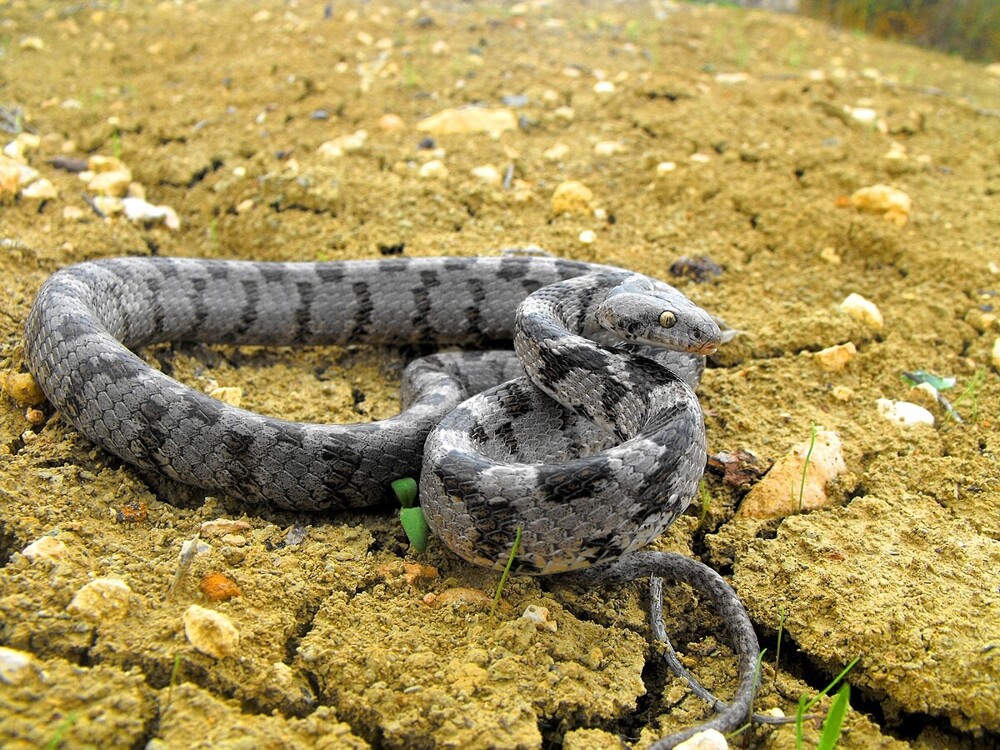
The cat snake (lat. Telescopus fallax) is a species of snake of the colubrid family. The snake is of medium size with a body length of 60-70 cm, maximum length - 100 cm. The head is sharply separated from the body by a neck interception. The body is slightly compressed laterally. The pupils are vertical. The color of the upper side of the body is light gray, yellow-gray or pinkish. On the back, along the spine, large, often oblique, blackish, brownish-gray or yellowish-brown spots run in one line, between which the color is slightly lighter than on the lateral surface of the body. Transverse stripes or smaller spots are located on the sides of the body and in the spaces between the dorsal spots. Prefers rocky slopes overgrown with sparse grass and shrub vegetation, semi-deserts, and surrounding mountain forests. It feeds on lizards, rodents, and birds.
10. Aesculapian snake 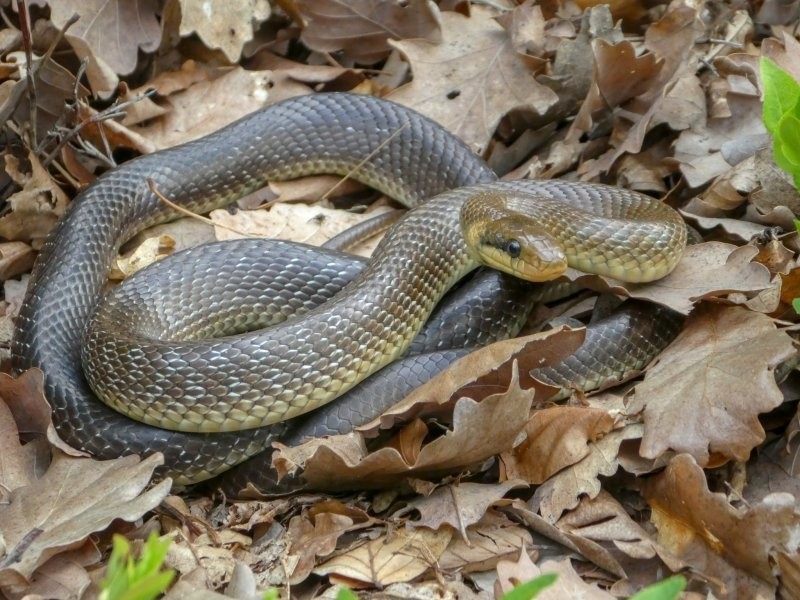
The Aesculapian snake or Aesculapian snake (lat. Zamenis longissimus) is a species of snake in the family Colubridae. Reaches a length of more than 2 m (the maximum size recorded for this species is 2.25 m). The general color background is yellowish-grayish-cream, sometimescream-brown or gray-brown. Whitish spots are visible from the mouth to the back of the head, and a blurred dark stripe stretches from the back edge of the eye to the corner of the mouth. The Aesculapian snake usually lives in wooded foothills (from beech to coniferous forests with evergreen undergrowth). It climbs trees using irregularities in the bark, against which it rests with the free edges of the abdominal scutes and the bends of the body. It can easily crawl from tree to tree along the branches of touching crowns. Avoids open places, preferring moist biotopes. The diet is dominated by rodents, shrews, bird eggs, chicks, and sometimes adult small songbirds. It suffocates the prey, squeezing it with body rings. It takes about four days to digest a large prey. This snake is a fairly aggressive snake. May cause painful bites.
Add your comment
You might be interested in:












